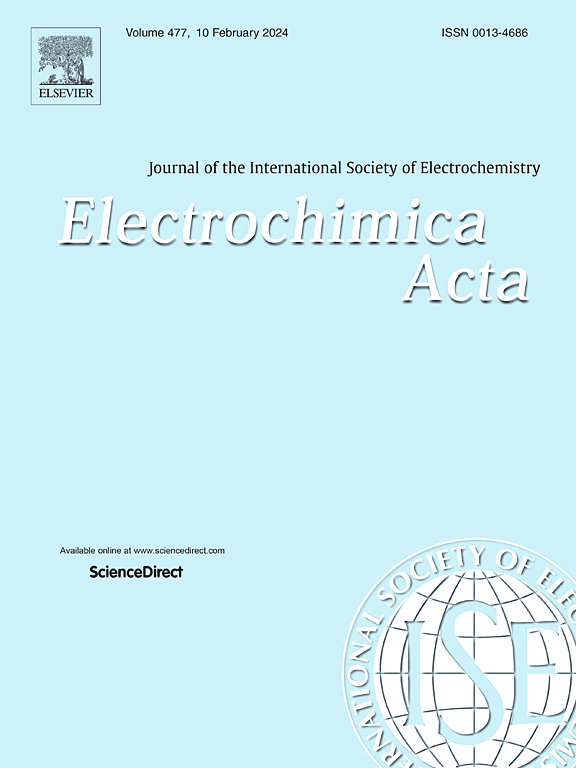Composition-activity relationship of first-row transition metal antimonates (MSb2O6, M = Mn, Co, Fe, and Ni) towards oxygen electrocatalysis
IF 5.6
3区 材料科学
Q1 ELECTROCHEMISTRY
引用次数: 0
Abstract
This study explores the electrocatalytic activity of first-row transition metal antimonates MSb2O6 (M = Mn, Co, Fe, and Ni) towards oxygen reduction (ORR) and oxygen evolution reactions (OER) in alkaline electrolytes. High-phase purity of the various antimonates is achieved by solid-state synthesis at 1000°C. The structure and composition of the oxide powders were examined by X-ray diffraction (XRD), transmission electron microscopy with energy-dispersive X-ray spectroscopy (TEM-EDX), scanning electron microscopy (SEM), and X-ray photoelectron spectroscopy (XPS). Electrochemical studies conducted in oxygen-saturated electrolytes using a rotating ring-disk electrode demonstrate that MnSb₂O₆ is the only antimonate in the series capable of catalyzing the ORR via the four-electron transfer pathway. On the other hand, CoSb2O6 exhibits the highest activity towards the OER. The activity of these complex materials is closely connected to changes in the population of 3d states associated with the first-row transition metal cation, which can be quantified by the pseudo-capacitive responses at potentials relevant to oxygen electrocatalysis. Our results suggest that populated Mn 3d states have the appropriate configuration to break the O2 bond, while vacant (holes) Co 3d states promote surface-bound OH radicals in the early stages of OER. Normalizing kinetically limited currents for ORR and OER by changes in population of d-states allows for benchmarking the intrinsic activity of catalytic sites in antimonates with other oxide structures, such as lanthanide perovskites.


第一排过渡金属锑酸盐(MSb2O6, M = Mn, Co, Fe, Ni)对氧电催化的组成-活性关系
本研究探讨了第一排过渡金属锑酸盐MSb2O6 (M = Mn, Co, Fe和Ni)在碱性电解质中对氧还原(ORR)和出氧反应(OER)的电催化活性。各种锑酸盐的高相纯度是通过在1000°C的固态合成实现的。采用x射线衍射仪(XRD)、透射电子能谱仪(TEM-EDX)、扫描电子显微镜(SEM)和x射线光电子能谱仪(XPS)对氧化粉末的结构和组成进行了表征。利用旋转环盘电极在氧饱和电解质中进行的电化学研究表明,mnsb2o₆是该系列中唯一能够通过四电子转移途径催化ORR的锑酸盐。另一方面,CoSb2O6对OER表现出最高的活性。这些复合材料的活性与与第一行过渡金属阳离子相关的三维态居群的变化密切相关,这可以通过与氧电催化相关的电位的赝电容响应来量化。我们的研究结果表明,填充的Mn 3d态具有适当的构型来破坏O2键,而空(空穴)Co 3d态在OER的早期阶段促进了表面结合的OH自由基。通过改变d态居群来规范ORR和OER的动力学限制电流,可以对锑酸盐中具有其他氧化物结构(如镧系钙钛矿)的催化位点的固有活性进行基准测试。
本文章由计算机程序翻译,如有差异,请以英文原文为准。
求助全文
约1分钟内获得全文
求助全文
来源期刊

Electrochimica Acta
工程技术-电化学
CiteScore
11.30
自引率
6.10%
发文量
1634
审稿时长
41 days
期刊介绍:
Electrochimica Acta is an international journal. It is intended for the publication of both original work and reviews in the field of electrochemistry. Electrochemistry should be interpreted to mean any of the research fields covered by the Divisions of the International Society of Electrochemistry listed below, as well as emerging scientific domains covered by ISE New Topics Committee.
 求助内容:
求助内容: 应助结果提醒方式:
应助结果提醒方式:


